Abstract
BACKGROUND: Each component of metabolic syndrome (MS) conveys increased cardiovascular disease risk, but as a combination they become much more powerful. Vigorous early management of the syndrome may have a significant impact on the prevention of both diabetes and cardiovascular disease. AIM: This study aims to determine the frequency of occurrence of MS and its relation to cardiovascular events among patients with type-2 diabetic mellitus. METHODS: The study group consisted of 218 type-2 diabetic patients. These were screened for hypertension, hyperlipidemia, obesity, microalbuminuria, and cardiovascular events. RESULTS: There were 128 (58.7%) males and 90 (41.3%) females. The mean age was 53.4 +/- 6.3 years and a mean body mass index (BMI) of 25.5 +/- 5.4 (males-23.4 +/- 4.2; females-26.2 +/- 5.7). MS was present in 55 (25.2%) of the study population. Systemic hypertension was the most common component of MS seen in 84 (38.5%) patients. The mean serum total cholesterol was 168.6 +/- 25.8 mg% (men 153 +/- 23; women 169 +/- 19; p > 0.05). Eight female and 12 male patients had serum total cholesterol > or = 200 mg%. Dyslipidemia occurs more commonly in males than females. Obesity was more common in female patients than in males. Out of 128 male type-2 patients with diabetes seen, 111 (86.7%) were without microalbuminuria. The corresponding figure among the females was 90% (81 out of 90 patients). CONCLUSIONS: The study demonstrated that MS was present in 25.2% of the study population. The syndrome and its different components were positively associated with a higher risk of stroke, peripheral vascular disease, and occurrence of microalbuminuria, p < 0.001. Ischemic heart disease occurs rarely in the population. A long-term, targeted, intensive intervention involving multiple cardiovascular risk factors is recommended to reduce the risk of both cardiovascular and microvascular events among patients with type-2 diabetic mellitus.
Full text
PDF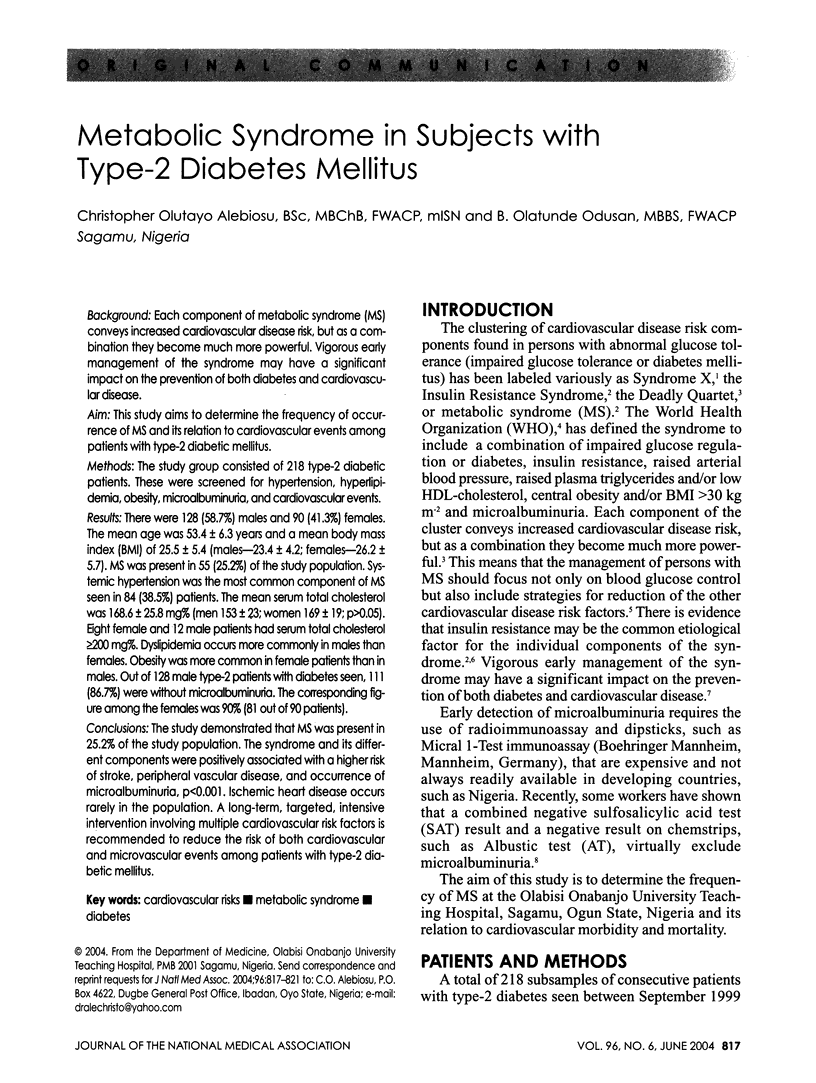
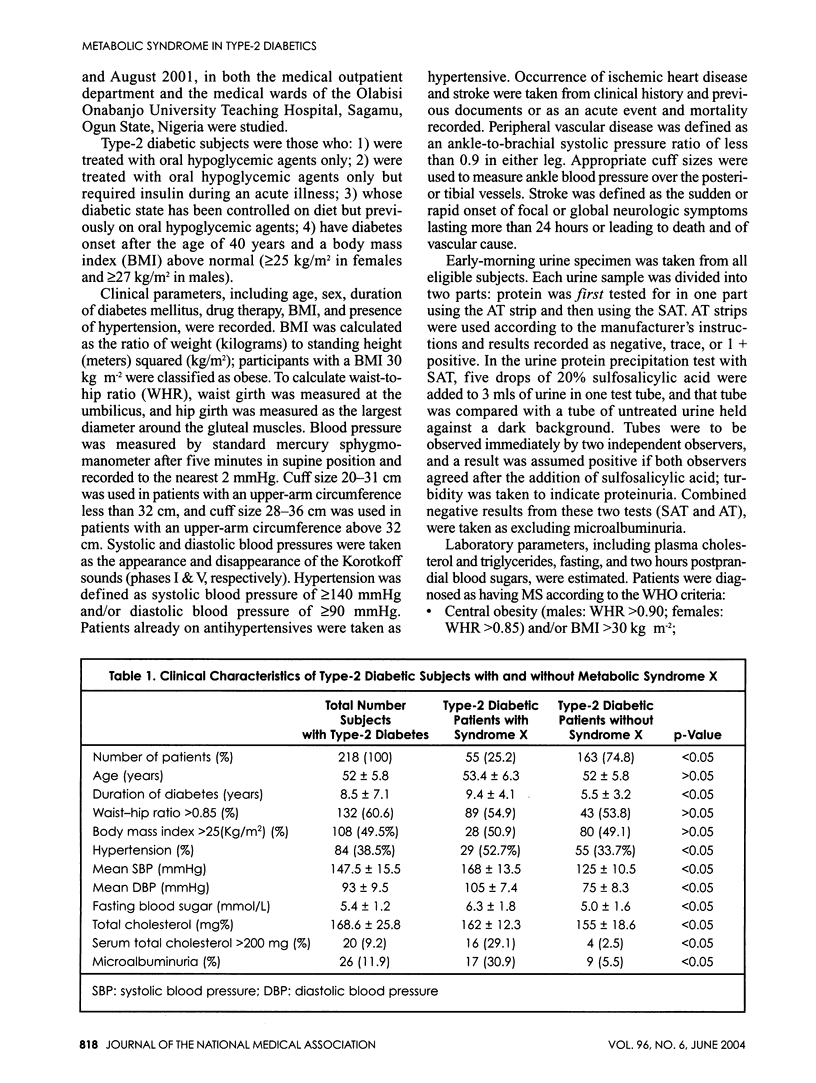
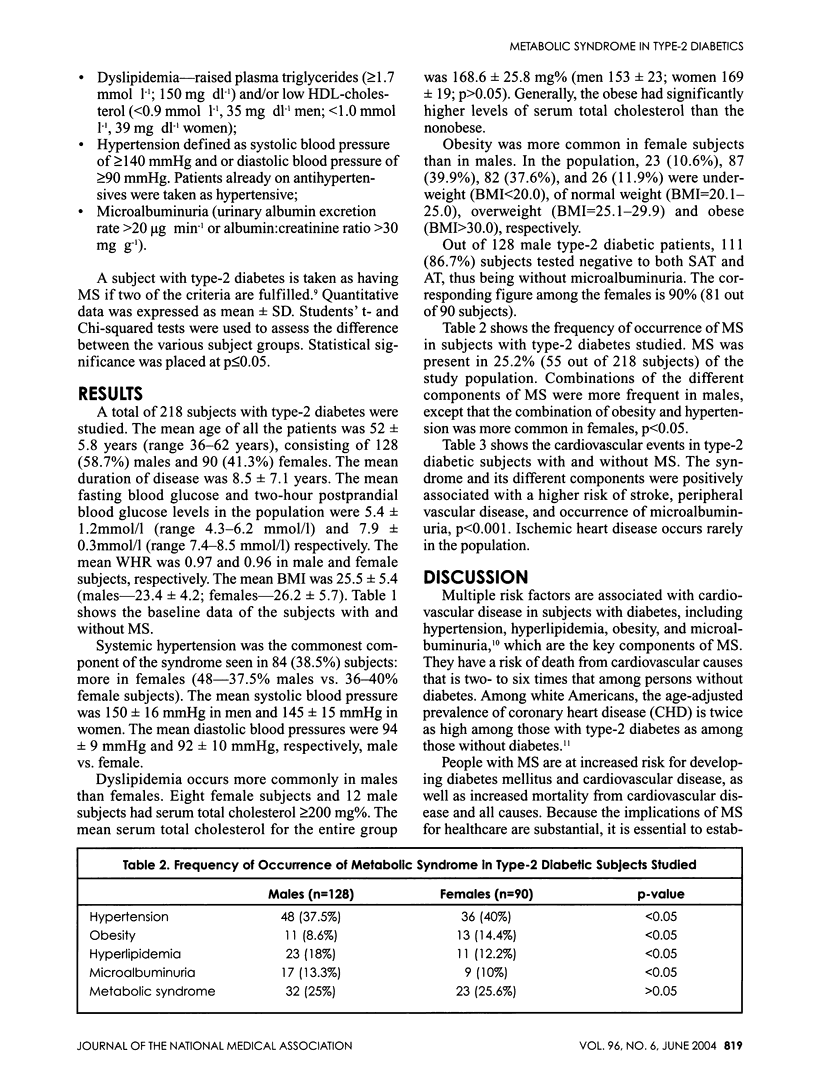
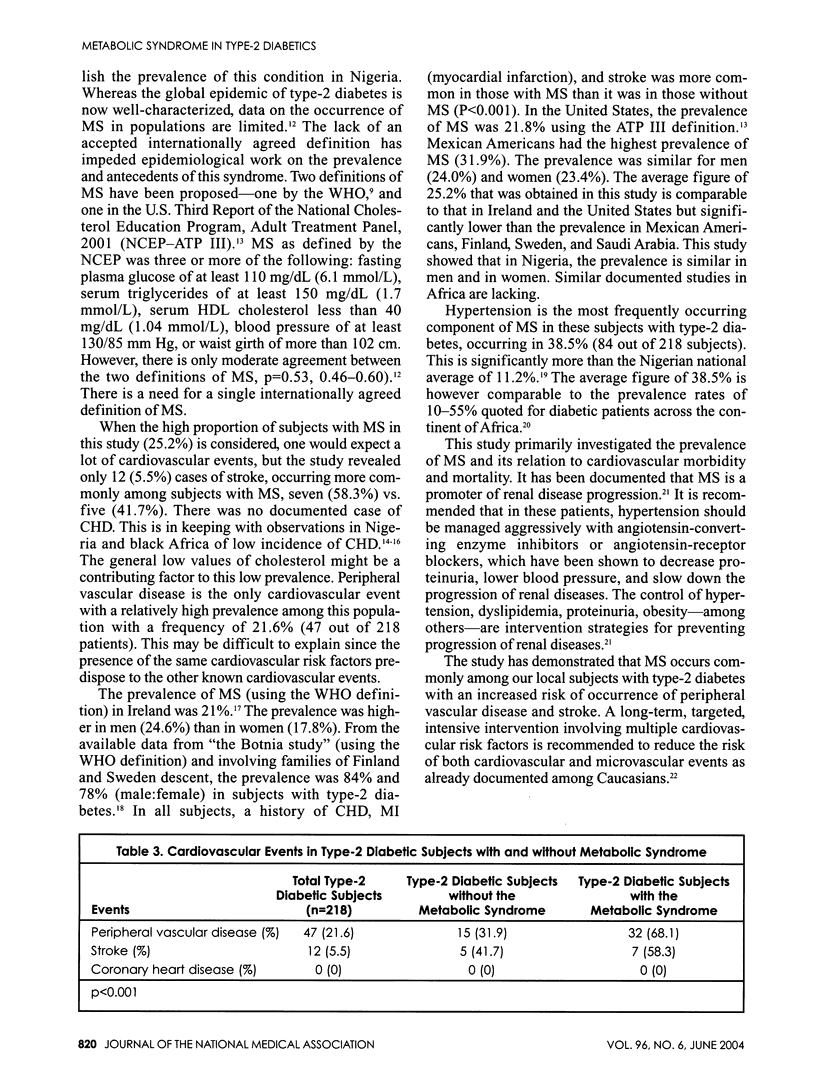
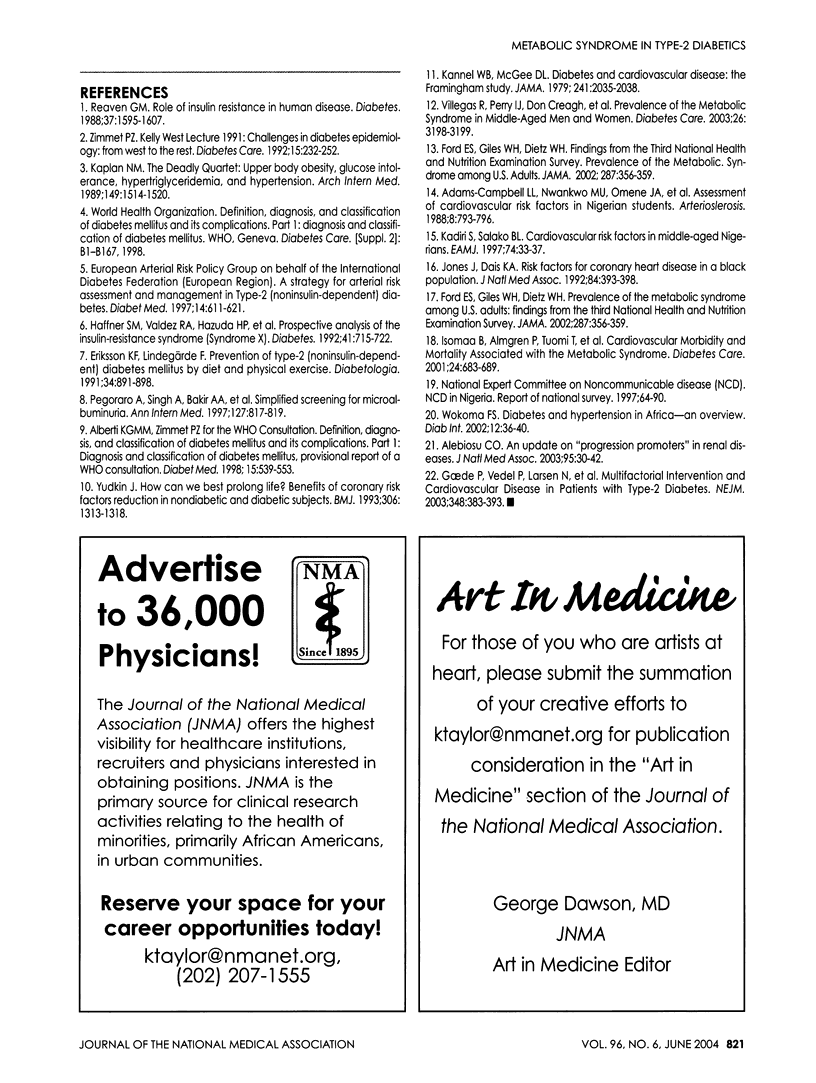
Selected References
These references are in PubMed. This may not be the complete list of references from this article.
- Alberti K. G., Zimmet P. Z. Definition, diagnosis and classification of diabetes mellitus and its complications. Part 1: diagnosis and classification of diabetes mellitus provisional report of a WHO consultation. Diabet Med. 1998 Jul;15(7):539–553. doi: 10.1002/(SICI)1096-9136(199807)15:7<539::AID-DIA668>3.0.CO;2-S. [DOI] [PubMed] [Google Scholar]
- Alebiosu C. O. An update on 'progression promoters' in renal diseases. J Natl Med Assoc. 2003 Jan;95(1):30–42. [PMC free article] [PubMed] [Google Scholar]
- Eriksson K. F., Lindgärde F. Prevention of type 2 (non-insulin-dependent) diabetes mellitus by diet and physical exercise. The 6-year Malmö feasibility study. Diabetologia. 1991 Dec;34(12):891–898. doi: 10.1007/BF00400196. [DOI] [PubMed] [Google Scholar]
- Ford Earl S., Giles Wayne H., Dietz William H. Prevalence of the metabolic syndrome among US adults: findings from the third National Health and Nutrition Examination Survey. JAMA. 2002 Jan 16;287(3):356–359. doi: 10.1001/jama.287.3.356. [DOI] [PubMed] [Google Scholar]
- Ford Earl S., Giles Wayne H., Dietz William H. Prevalence of the metabolic syndrome among US adults: findings from the third National Health and Nutrition Examination Survey. JAMA. 2002 Jan 16;287(3):356–359. doi: 10.1001/jama.287.3.356. [DOI] [PubMed] [Google Scholar]
- Gaede Peter, Vedel Pernille, Larsen Nicolai, Jensen Gunnar V. H., Parving Hans-Henrik, Pedersen Oluf. Multifactorial intervention and cardiovascular disease in patients with type 2 diabetes. N Engl J Med. 2003 Jan 30;348(5):383–393. doi: 10.1056/NEJMoa021778. [DOI] [PubMed] [Google Scholar]
- Haffner S. M., Valdez R. A., Hazuda H. P., Mitchell B. D., Morales P. A., Stern M. P. Prospective analysis of the insulin-resistance syndrome (syndrome X). Diabetes. 1992 Jun;41(6):715–722. doi: 10.2337/diab.41.6.715. [DOI] [PubMed] [Google Scholar]
- Isomaa B., Almgren P., Tuomi T., Forsén B., Lahti K., Nissén M., Taskinen M. R., Groop L. Cardiovascular morbidity and mortality associated with the metabolic syndrome. Diabetes Care. 2001 Apr;24(4):683–689. doi: 10.2337/diacare.24.4.683. [DOI] [PubMed] [Google Scholar]
- Jones J., Dais K. A. Risk factors for coronary heart disease in a black population. J Natl Med Assoc. 1992 May;84(5):393–398. [PMC free article] [PubMed] [Google Scholar]
- Kannel W. B., McGee D. L. Diabetes and cardiovascular disease. The Framingham study. JAMA. 1979 May 11;241(19):2035–2038. doi: 10.1001/jama.241.19.2035. [DOI] [PubMed] [Google Scholar]
- Kaplan N. M. The deadly quartet. Upper-body obesity, glucose intolerance, hypertriglyceridemia, and hypertension. Arch Intern Med. 1989 Jul;149(7):1514–1520. doi: 10.1001/archinte.149.7.1514. [DOI] [PubMed] [Google Scholar]
- Pegoraro A., Singh A., Bakir A. A., Arruda J. A., Dunea G. Simplified screening for microalbuminuria. Ann Intern Med. 1997 Nov 1;127(9):817–819. doi: 10.7326/0003-4819-127-9-199711010-00007. [DOI] [PubMed] [Google Scholar]
- Reaven G. M. Banting lecture 1988. Role of insulin resistance in human disease. Diabetes. 1988 Dec;37(12):1595–1607. doi: 10.2337/diab.37.12.1595. [DOI] [PubMed] [Google Scholar]
- Villegas Raquel, Perry Ivan J., Creagh Don, Hinchion Rita, O'Halloran Domhnall. Prevalence of the metabolic syndrome in middle-aged men and women. Diabetes Care. 2003 Nov;26(11):3198–3199. doi: 10.2337/diacare.26.11.3198-a. [DOI] [PubMed] [Google Scholar]
- Yudkin J. S. How can we best prolong life? Benefits of coronary risk factor reduction in non-diabetic and diabetic subjects. BMJ. 1993 May 15;306(6888):1313–1318. doi: 10.1136/bmj.306.6888.1313. [DOI] [PMC free article] [PubMed] [Google Scholar]


